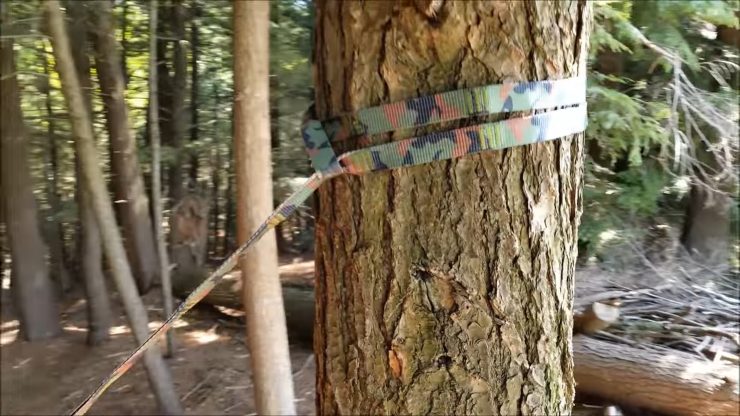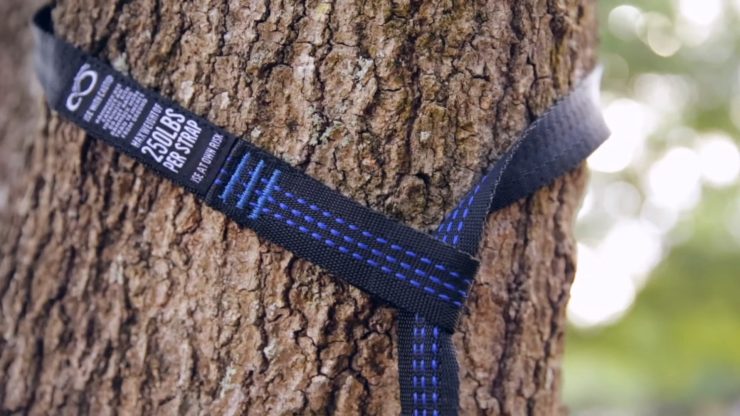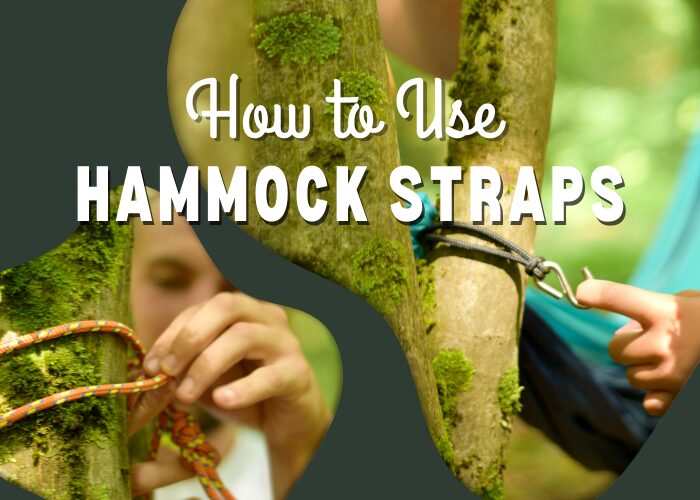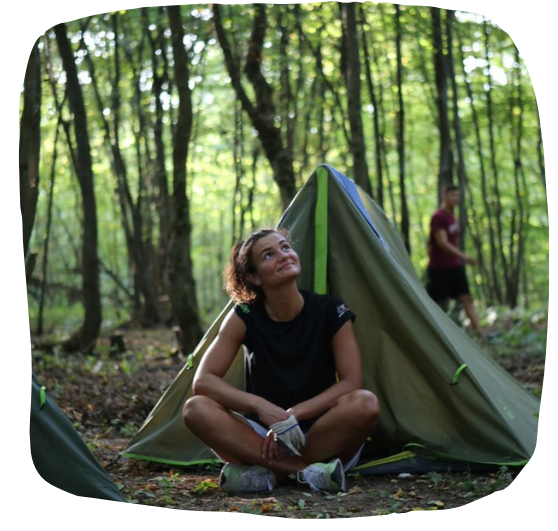The biggest issue for some people new to Hammock Camping is figuring out how to use the hammock straps. There are many different types of straps and each operates differently.
Well, I own a number of different types hammock straps myself and I would love to show you how I use them to set up my hammocks. Some of the methods for using hammock straps are easier than others, but none of them are overly complicated.
Contents
Which Straps Do You Have?

The first thing you have to do is identify which type of straps you have. If you already know this information and are just looking for directions then skip ahead.
There are eco-friendly straps, long straps with loops, short straps with loops, and even easily adjustable straps. Here I will try and will help you determine which straps you have.
- Eco-friendly Straps- If your straps are about 2 inches thick, have metal rings and came with two S hooks then you likely have eco-friendly straps. Eco-friendly straps are marketed as being good for the trees but they are significantly heavier than other straps.I wouldn’t suggest buying these but I’ve boughten hammocks that have come with them. In that case, I just dealt with it. Just because they’re called eco-friendly doesn’t mean they are the only environmentally friendly option. Most tree straps are.
- Long Straps With Two Loops- If your straps are longer than a foot or two then I would consider these longer straps. Most of these have two loops in the ends. The good thing about the length of these is that usually they can be used alone as your suspension. There’s also more than one way to use these straps.
- Short Straps with Two Loops- Really short straps are usually only made to create an anchor point and you will need to use something else for your suspension. There are different ways that you could attach your suspension base on what kind it is. Hammocks like Hennessy Hammocks are designed to be tied on to with a cord using knots.
- Easily Adjustable Straps- Easily adjustable straps are the straps that you see that have many loops on one end. They are super easy to use. If you don’t have straps and you are new to hammocking then these are the ones that I would suggest you get. The first time that I saw these it was an ENO Atlas model but now there are lots of companies that make them.
The four styles I’ve just listed are the main types of straps that you will find. One of these types will often come with a hammock that you buy online (if it comes with straps at all).
It is possible that you could get a different variation of one of these but one of the methods for hanging that I’m about to show you will probably work.
For instance, I have seen eco-friendly straps that are short instead of long, this really just means that you need to treat them like shorter straps with loops and attach a suspension system to it
(or attach the hammock directly).
Using Eco-Friendly Straps
Eco-friendly straps are pretty easy to use but as I said earlier, they are heavy. Another thing that some people do not like about these straps, myself included, is that they use metal pieces on other metal pieces, which can make noises.
A positive to using these types of hammock straps is that they are long enough to act as both the anchor point and suspension line most of the time.
Here is the most popular way to use eco-friendly straps;
- You’re going to want to start with the stitched loop facing inwards toward your hammock
- Now Wrap of the metal loop around the tree once and then feed it through the stitched loop
- Now wrap the strap around the tree in the opposite direction covering itself to hold everything in place
- When you have the strap facing inwards at the desired length for your suspension, feed it under one or two of the wraps around the tree that you have just done, and back through the stitched Loop.
- Attach your S hook on to the metal Loop, Attach either your carabiner, soft shackle, or continuous loop to the hook. I prefer to use my continuous loop. (The continuous loop is a loop at the end of your hammock)
- repeat the process on the other side.
- Lay in your hammock and relax
That’s pretty much all you need to know for eco-friendly three straps. Although they are marketed as being eco-friendly they are not the only eco-friendly option. I’ve said before that I suggest any set of straps strapped that’s 1 inch or wider for tree healthiness.
Again I do not recommend that you buy these types of straps but some hammocks come with them so it is good to know how to use them.
Long Straps with Two Loops

Long straps that come with two loops at either end are pretty easy to use just like most straps. It can be a little confusing to figure out how to use if you’ve never seen them used before. These can come in different sizes but they’re generally around 10 feet long.
The loops that come on these straps are generally triple stitched or better. I can’t recall ever seeing these with metal loops on them.
There are two ways that you can use these straps, One of these methods is better if you are using a carabiner. For the other method all you need is a loop; if you really needed to you could tie a loop at the end of your suspension.
If you are using the first method that I show you then you will want to use a carabiner or something similar.
Method One
- Hold one of the Stitched loops in-place facing inwards toward where hammock will be.
- Continue to hold this loop while wrapping your strap around the tree, tightly, until you have the length required for your suspension.
- Feed the suspension side through the loop that you were holding and pull it tight.
- Attach a carabiner or hook from the loop on the suspension to the loop at end of your hammock.
- Repeat this on the other side.
- Get into your hammock and relax.
Method Two
(If you’re using a whoopie sling you are most likely doing this method)
- Hold one of the stitched loops in place facing in towards where the hammock is going to be.
- Wrap the strap around the tree once and feed it through the loop and pull tight. (Most of the strap will be fed through the loop and will be hanging around the tree you will still have to hold the loop up there to stop it from falling down at this point)
- Tie a marlin-spike hitch and insert a toggle.
- Repeat this on the other side with the other anchor.
- Hook your hammock’s end loops around the knot of the Marlin Spike hitch On each strap.
- Lie down and relax in your hammock.
It is very important to note that when you’re using the marlin spike hitch you need to make sure that you are hanging your loops on to the knot and not the toggle itself. The toggle is able to fall out and it is also more likely to break.
When selecting a toggle, make sure that you choose something solid, it won’t be holding your weight completely but the knot will be putting some pressure on it. Last weekend I got lazy and thought that a small stick would hold the knot and my toggle actually broke. You can also buy toggles at some hammock specialty stores.
Always remember to sit in your hammock first and transfer rate your weight onto it slowly. Always ensure that everything is set up properly and there’s no chance of falling.
How to tie a Marlin Spike Hitch
The marlin spike hitch is a pretty easy knot to tie and it’s an even easier knot to take out
Here’s how you tie it;
- You make a loop in the strap
- You reach up through that loop, grab the strap pull it through
- place your toggle in there and pull everything tight
Remember not to hang from the toggle. You want to hang from the knot itself
If you pulled everything tight the toggle should just be hanging there with a knot around it. I’ve tried using this with carabiners and I find it doesn’t work as well as the other method. I also don’t always like to bring metal carabiners with me especially if I’m going on a big, big hike. The weight of solid carabiners can add up quickly.
Short Straps with Two Loops
These straps are generally only around a foot, they are sometimes a little bit longer. Usually, they can only be wrapped around a tree once or twice. These straps are super easy to create an anchor point with but do require a little bit more effort because they are not long enough to be the full suspension system for most setups.
Here’s how you use them to create an anchor point
- Wrap them around the tree
- Feed the loops through each other
- Pull one of them tight and make sure it’s facing inwards towards your hammock
That’s really all it takes to set it up, next what you have to do is figure out how you are going to support your hammock. If the trees are in the perfect location you might be able to clip a carabiner from the loops at the ends of your hammock(continuous loop) to these straps.
If the trees aren’t in a perfect location then you’re going to have to create a suspension system using either more straps, cord or a rope.
Easily Adjustable Straps
These are the straps that you see that have a number of loops going up on one side of the strap. I’ve mentioned this before but the first time I saw a set of these was about 10 years ago and they were called the ENO Atlas. I picked up a set of those and they are very easy to use. For somebody brand new to hammocking this would be the best solution for them.
I think it’s best to use these straps with a carabiner. You could also use a soft shackle if you were concerned about weight. Even with the carabiners these straps usually do not come close to being as heavy as the eco-friendly straps.
I know I mentioned the ENO Atlas but lately, these straps have been all over different the marketplaces under numerous different names. Here’s how you use them;
- Wrap the strap around the tree
- Feed the end with all of the loops through the end with no loops and pull it tight.
- Clip your carabiner to the end loops of your hammock and to the loop on the strap that is in the best place for your setup.
- Do this on both sides.
- Lay down in your hammock and chillax.
It is really that easy to use these straps. There’s not really too much that you need to worry about. If the strap is too long and all of the loops hang too low Then wrap your strap around an extra time before feeding it through the loop.
DIY
There was a time when I had lost a set of hammock straps and did not want to buy a new one because they were expensive. I had some tubular nylon webbing that people use to make rock climbing anchors with just sitting around. I figured I could use some of this webbing to make my own hammock straps. It was really easy.
What I did was cut a long strip of the tubular webbing and tied it into a loop that was about 3 feet long. That was all I did. Now all I have to do with this loop of webbing is go to a tree wrap it around, and tuck one end inside of the other. Now I can just attach a carabiner to the loop that is inside the other, and attach this same carabiner to my hammock.
If you are doing this ( or any DIY solution) then you’re doing so at your own risk. I highly recommend using hammock straps unless you know what you are doing and know that the material that you are using is designed to hold human weight.
Strap Safety
It’s always important to take safety into account when you’re setting up your hammock straps. This is important no matter what type of hammock straps you choose to use. Safety is especially important with DIY solutions.
Remember to always inspect your setup before you get into it to ensure that you’ve done what you’ve intended to do properly. Also, always make sure that you slowly transition your weight on to the hammock and you should sit down in it before you lay down.
You should also make sure that you know what condition your straps are in at all times. The easiest way to do this is to inspect it after every use. When it comes to hammock straps the most important thing to inspect is the stitching that holds the loops shut.
Most hammock straps are triple stitched or better but if you see a line of stitching come completely off then replace your straps immediately.
Nowadays hammock straps are not overly expensive which makes it is easier to replace gear that has been worn down. Please consider this if you feel like your gear has been worn down to a point where is no longer safe to use. You can also check out other cool pieces of gear for hammock camping before your next adventure.
Conclusion
Overall Hammock straps are really easy to use. In my post, I hope you were able to find a method that will work with your straps so that you can go out and relax! If you weren’t able to find a way that works for you then please let me know in the comments below.
If You have straps that don’t fit into one of the categories above then I would be really interested in seeing them. Happy hammocking!
References:


